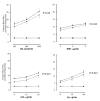Impaired vascular function after exposure to diesel exhaust generated at urban transient running conditions
- PMID: 20653945
- PMCID: PMC2918524
- DOI: 10.1186/1743-8977-7-19
Impaired vascular function after exposure to diesel exhaust generated at urban transient running conditions
Abstract
Background: Traffic emissions including diesel engine exhaust are associated with increased respiratory and cardiovascular morbidity and mortality. Controlled human exposure studies have demonstrated impaired vascular function after inhalation of exhaust generated by a diesel engine under idling conditions.
Objectives: To assess the vascular and fibrinolytic effects of exposure to diesel exhaust generated during urban-cycle running conditions that mimic ambient 'real-world' exposures.
Methods: In a randomised double-blind crossover study, eighteen healthy male volunteers were exposed to diesel exhaust (approximately 250 microg/m3) or filtered air for one hour during intermittent exercise. Diesel exhaust was generated during the urban part of the standardized European Transient Cycle. Six hours post-exposure, vascular vasomotor and fibrinolytic function was assessed during venous occlusion plethysmography with intra-arterial agonist infusions.
Measurements and main results: Forearm blood flow increased in a dose-dependent manner with both endothelial-dependent (acetylcholine and bradykinin) and endothelial-independent (sodium nitroprusside and verapamil) vasodilators. Diesel exhaust exposure attenuated the vasodilatation to acetylcholine (P < 0.001), bradykinin (P < 0.05), sodium nitroprusside (P < 0.05) and verapamil (P < 0.001). In addition, the net release of tissue plasminogen activator during bradykinin infusion was impaired following diesel exhaust exposure (P < 0.05).
Conclusion: Exposure to diesel exhaust generated under transient running conditions, as a relevant model of urban air pollution, impairs vasomotor function and endogenous fibrinolysis in a similar way as exposure to diesel exhaust generated at idling. This indicates that adverse vascular effects of diesel exhaust inhalation occur over different running conditions with varying exhaust composition and concentrations as well as physicochemical particle properties. Importantly, exposure to diesel exhaust under ETC conditions was also associated with a novel finding of impaired of calcium channel-dependent vasomotor function. This implies that certain cardiovascular endpoints seem to be related to general diesel exhaust properties, whereas the novel calcium flux-related effect may be associated with exhaust properties more specific for the ETC condition, for example a higher content of diesel soot particles along with their adsorbed organic compounds.
Figures







Similar articles
-
Diesel exhaust inhalation causes vascular dysfunction and impaired endogenous fibrinolysis.Circulation. 2005 Dec 20;112(25):3930-6. doi: 10.1161/CIRCULATIONAHA.105.588962. Circulation. 2005. PMID: 16365212 Clinical Trial.
-
Combustion-derived nanoparticulate induces the adverse vascular effects of diesel exhaust inhalation.Eur Heart J. 2011 Nov;32(21):2660-71. doi: 10.1093/eurheartj/ehr195. Epub 2011 Jul 13. Eur Heart J. 2011. PMID: 21753226 Free PMC article. Clinical Trial.
-
Persistent endothelial dysfunction in humans after diesel exhaust inhalation.Am J Respir Crit Care Med. 2007 Aug 15;176(4):395-400. doi: 10.1164/rccm.200606-872OC. Epub 2007 Apr 19. Am J Respir Crit Care Med. 2007. PMID: 17446340 Clinical Trial.
-
A systematic review of the health effects associated with the inhalation of particle-filtered and whole diesel exhaust.Inhal Toxicol. 2020 Jan;32(1):1-13. doi: 10.1080/08958378.2020.1725187. Epub 2020 Feb 26. Inhal Toxicol. 2020. PMID: 32100584 Free PMC article.
-
Controlled human exposures to diesel exhaust.Swiss Med Wkly. 2012 May 31;142:w13597. doi: 10.4414/smw.2012.13597. eCollection 2012. Swiss Med Wkly. 2012. PMID: 22653425 Review.
Cited by
-
The Impact of Metformin on Dust-Induced Histopathological Changes and Oxidative Stress in the Liver: An Insight into Dust Concentration and Liver Biomarkers in Animal Models.Rep Biochem Mol Biol. 2023 Jul;12(2):306-317. doi: 10.61186/rbmb.12.2.306. Rep Biochem Mol Biol. 2023. PMID: 38317816 Free PMC article.
-
Controlled human exposure to diesel exhaust: a method for understanding health effects of traffic-related air pollution.Part Fibre Toxicol. 2022 Feb 25;19(1):15. doi: 10.1186/s12989-022-00454-1. Part Fibre Toxicol. 2022. PMID: 35216599 Free PMC article. Review.
-
Potential role of polycyclic aromatic hydrocarbons as mediators of cardiovascular effects from combustion particles.Environ Health. 2019 Aug 22;18(1):74. doi: 10.1186/s12940-019-0514-2. Environ Health. 2019. PMID: 31439044 Free PMC article. Review.
-
Controlled human exposure to diesel exhaust: results illuminate health effects of traffic-related air pollution and inform future directions.Part Fibre Toxicol. 2022 Feb 9;19(1):11. doi: 10.1186/s12989-022-00450-5. Part Fibre Toxicol. 2022. PMID: 35139881 Free PMC article. Review.
-
Altered nitric oxide bioavailability contributes to diesel exhaust inhalation-induced cardiovascular dysfunction in man.J Am Heart Assoc. 2013 Feb 19;2(1):e004309. doi: 10.1161/JAHA.112.004309. J Am Heart Assoc. 2013. PMID: 23525434 Free PMC article. Clinical Trial.
References
-
- Gauderman WJ, Avol E, Gilliland F, Vora H, Thomas D, Berhane K, McConnell R, Kuenzli N, Lurmann F, Rappaport E, Margolis H, Bates D, Peters J. The effect of air pollution on lung development from 10 to 18 years of age. The New England journal of medicine. 2004;351:1057–1067. doi: 10.1056/NEJMoa040610. - DOI - PubMed
Publication types
MeSH terms
Substances
Grants and funding
LinkOut - more resources
Full Text Sources

